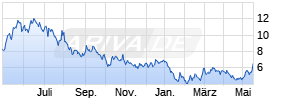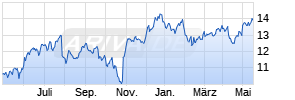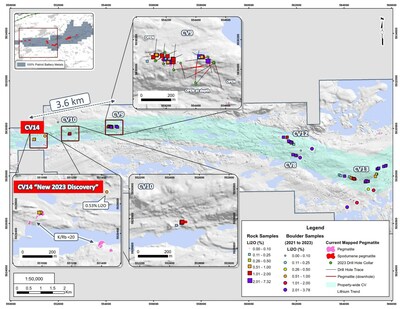
Patriot Discovers New Spodumene-Pegmatite Occurrence (CV14) at Corvette, Quebec, Canada
PR Newswire
VANCOUVER, BC, March 24, 2024
VANCOUVER, BC, March 24, 2024 /PRNewswire/ - March 25, 2024 – Sydney, Australia
REGIONAL
- New spodumene pegmatite occurrence discovered (herein termed "CV14"), situated along geological trend of the CV9 and CV10 spodumene pegmatite clusters.
- Grab samples assays of 0.94% Li2O and 0.86% Li2O.
- CV14 spodumene pegmatite outcrop ~33 m x 9 m in size.
- ~3.6 km long prospective trend extending from CV9, through CV10, to CV14.
- Significant areas of the Property remain to be evaluated for lithium pegmatite.
- The 2024 surface exploration program is planned to consist of channel sampling of known LCT pegmatites (including CV14), detailed geological mapping over the CV5 & CV13 spodumene pegmatites, and regional prospecting over unexplored areas of the Property.
CV5 PEGMATITE
- Extensive spodumene pegmatite boulder field, discovered south of the CV5 Spodumene Pegmatite, strengthens interpretation of CV5 trending eastward towards CV4, and indicates additional yet to be discovered spodumene pegmatite(s) to the south and outside of the currently discovered pegmatite.
- A tightly spaced ground-magnetic survey completed over the CV5 through CV13 corridor has further resolved local trends and will provide strong guidance as drilling advances through this area.
CV13 PEGMATITE
- A total of 147 m of channel sampling completed at the CV13 Spodumene Pegmatite with results including:
- 13.4 m at 1.22% Li2O; 6.4 m at 1.44% Li2O; and 5.4 m at 1.93% Li2O.
- 16.7 m at 0.80% Li2O, including 8.1 m at 1.36% Li2O.
- Data will help constrain the geological model for CV13 ahead of a maiden mineral resource estimate scheduled for Q3 2024.
Darren Smith, Vice President of Exploration for the Company, comments:"The 2023 surface program, albeit significantly reduced in scope due to the unprecedented wildfires in the province, was successful in identifying a new spodumene pegmatite occurrence (CV14) along trend of the CV9 and CV10 spodumene pegmatites. The discovery highlights the extensive nature of the spodumene mineralized system along the CV Lithium Trend, which extends across the Property where a large portion remains unexplored for lithium pegmatite. We are excited to follow-up this area with systematic surface exploration as this local prospective lithium pegmatite trend has now been extended to approximately 3.6 km. Coupled with the numerous spodumene pegmatite boulders discovered over the Property, there remains strong potential for additional discoveries at Corvette."
ARIVA.DE Börsen-Geflüster
Kurse
 |
 |
Patriot Battery Metals Inc. (the "Company" or "Patriot") (TSX: PMET) (ASX: PMT) (OTCQX: PMETF) (FSE: R9GA) is pleased to announce results from its 2023 surface exploration campaign at the Corvette Property. The Corvette Property (the "Property" or "Project"), wholly owned by the Company, is located in the Eeyou Istchee James Bay region of Quebec. The CV5 Spodumene Pegmatite, with a maiden mineral resource estimate of 109.2 Mt at 1.42% Li2O inferred1, is situated central to the Property, approximately 13.5 km south of the regional and all–weather Trans-Taiga Road and powerline infrastructure.
The 2023 surface exploration program at Corvette included ground geophysics, geological mapping, channel sampling, and regional prospecting. The program was completed sporadically over the summer-fall field season due to the unprecedented wildfires in the province, which significantly reduced the program's scope.
Despite the disruptions, the 2023 surface exploration at Corvette continued to build upon prior success, highlighted by the discovery of a new spodumene pegmatite occurrence, herein termed "CV14", located southwest along the same magnetic trend as the CV9 and CV10 spodumene pegmatite clusters (Figure 1). Grab sample assays from the principal pegmatite outcrop (~33 m x 9 m), comprised of spodumene hosted in a smoky-quartz and feldspar groundmass, include 0.94% Li2O and 0.86% Li2O (Figure 2 and Figure 3). Collectively, CV14 forms part of an approximate 3.6 km long prospective spodumene pegmatite trend extending through CV10, and to the CV9 Spodumene Pegmatite. This discovery at CV14 highlights a local trend of growing significance and prospectivity, and requires additional prospecting and mapping.
Additionally, approximately 450 m up-ice to the northeast of CV14 a mineralized pegmatite boulder was discovered (0.53% Li2O). Based on interpreted glacial ice direction in the area, it may suggest the potential for a yet to be discovered lithium pegmatite to be present to the north-northeast of the primary CV9-CV10-CV14 trend. Limited surface exploration has been completed in this area to date.
A total of 474 surface rock grab/chip samples were collected over the course of the 2023 prospecting program. In addition to the discovery of the CV14 spodumene pegmatite occurrence (outcrop), a plethora of spodumene mineralized pegmatite boulders were discovered south of the CV5 Spodumene Pegmatite with 29 boulders, dominantly subangular and 1-3 m in size, assaying between 0.49% Li2O to 3.22% Li2O (Figure 4 and Figure 5). Interpretation of glacial ice movement over the Property indicates that, although many of these boulders are undoubtedly sourced from the principal CV5 Pegmatite body, a significant number indicate spodumene pegmatite(s) is present near-surface immediately south of CV5, and along strike eastwardly of the principal CV5 pegmatite body towards CV4, where it remains open.
Other mineralized boulders on the property also suggest undiscovered spodumene pegmatite to the north of the primary CV Lithium Trend (Figure 4). These include a large (2 m x 2 m) mineralized boulder (1.00% Li2O) discovered in 2019 to the north of the CV5–13 corridor, suggesting potential for yet to be discovered spodumene pegmatite north of CV5. Also, two mineralized boulders (2.20% and 2.69% Li2O), discovered in 2021, located northeast of the CV8 Spodumene Pegmatite suggest potential for yet to be discovered spodumene pegmatite northeast of CV12 and north of CV13.
A tightly spaced (50 m) ground magnetic survey over the CV5 through CV13 corridor was also completed in 2023. The data has further resolved local geological trends along the corridor and will provide strong guidance as drilling advances through this area (Figure 6). There is a distinct lack of outcrop over the corridor due to glacial till cover, further highlighting the value of the magnetic dataset to assist in understanding the local structure and trends which can be used as a general proxy to interpret pegmatite location.
At CV13, the surface channeling campaign, which began in 2022, continued in 2023 with 147 m of channel sampling completed. Results in 2023 include 13.4 m at 1.22% Li2O, 6.4 m at 1.44% Li2O, 5.4 m at 1.93% Li2O, and 16.7 m at 0.80% Li2O, including 8.1 m at 1.36% Li2O. A peak sample of 6.43% Li2O (over 0.5 m) was also collected. Of the 147 m of channel sampling completed in 2023 at CV13, a total of 139 m consisted of pegmatite and collectively averaged 0.51% Li2O and 120 ppm Ta2O5. The channel sampling data, which effectively approximates a horizontal drill hole, will help constrain the geological model for CV13 ahead of a maiden mineral resource estimate scheduled for Q3 2024.
The 2023 surface work also included initial prospecting over approximately 1/3 of the Property's Corvette East claim block. Although a significant amount of pegmatite was discovered in this area of the Property, no spodumene pegmatite was identified. However, multiple samples returned anomalous pathfinder geochemistry, including low K/Rb ratios indicating evolved and highly fractionated pegmatites are present. The area remains of high interest for continued surface exploration with a significant number of LiDAR derived targets remaining to be prospected (Figure 7).
The 2024 surface exploration campaign is currently being designed; however, is anticipated to include:
- Follow-up of the CV14 Spodumene Pegmatite discovery with targeted prospecting traverses and mapping, as well as channel sampling.
- Follow-up of the multiple boulder fields indicating yet to be discovered spodumene pegmatite.
- Additional detailed geological mapping of the CV5 Spodumene Pegmatite to further constrain the geological model at surface.
- Continued channel sampling of the CV5 and CV13 pegmatites to constrain the geological model near surface and support an indicated mineral resource classification.
1 The CV5 mineral resource estimate (109.2 Mt at 1.42% Li2O and 160 ppm Ta2O5 inferred) is reported at a cut-off grade of 0.40% Li2O with an effective date of June 25, 2023 (through drill hole CV23-190). Mineral resources are not mineral reserves as they do not have demonstrated economic viability. Largest in the Americas based on contained LCE.
A Quality Assurance / Quality Control protocol following industry best practices was incorporated into the program and included insertion of quartz blanks and certified reference materials into sample batches submitted to the laboratory.
All surface samples collected were shipped to SGS Canada's laboratory in Val-d'Or, QC, for sample preparation (code PRP89 special) which includes drying at 105°C, crush to 90% passing 2 mm, riffle split 250 g, and pulverize 85% passing 75 microns. The pulps were shipped by air to SGS Canada's laboratory in Burnaby, BC, where the samples were homogenized and subsequently analyzed for multi-element (including Li and Ta) using sodium peroxide fusion with ICP-AES/MS finish (codes GE_ICP91A50 and GE_IMS91A50).
Management cautions that prospecting surface rock samples and associated assays, as discussed herein, are selective by nature and represent a point location, and therefore may not necessarily be fully representative of the mineralized horizon sampled.
The CV Lithium Trend is an emerging spodumene pegmatite district discovered by the Company in 2017 and is interpreted to span more than 50 kilometres across the Corvette Property. The core area includes the approximate 4.4 km long CV5 Spodumene Pegmatite, which hosts a maiden mineral resource estimate of 109.2 Mt at 1.42% Li2O inferred1.
To date, eight (8) distinct clusters of lithium pegmatite have been discovered across the Corvette Property – CV4, CV5, CV8, CV9, CV10, CV12, CV13, and the recently discovered CV14. Given the proximity of some pegmatite outcrops to each other, as well as the shallow till cover in the area, it is probable that some of the outcrops may reflect a discontinuous surface exposure of a single, larger pegmatite "outcrop" subsurface.
The information in this news release that relates to exploration results for the Corvette Property is based on, and fairly represents, information compiled by Mr. Darren L. Smith, M.Sc., P.Geo., who is a Qualified Person as defined by National Instrument 43-101 – Standards of Disclosure for Mineral Projects, and member in good standing with the Ordre des Géologues du Québec (Geologist Permit number 01968), and with the Association of Professional Engineers and Geoscientists of Alberta (member number 87868). Mr. Smith has reviewed and approved the technical information in this news release.
Mr. Smith is Vice President of Exploration for Patriot Battery Metals Inc. and holds common shares and options in the Company.
Mr. Smith has sufficient experience, which is relevant to the style of mineralization, type of deposit under consideration, and to the activities being undertaken to qualify as a Competent Person as described by the Australasian Code for Reporting of Exploration Results, Mineral Resources and Ore Reserves (the JORC Code). Mr. Smith consents to the inclusion in this news release of the matters based on his information in the form and context in which it appears.
Patriot Battery Metals Inc. is a hard-rock lithium exploration company focused on advancing its district-scale 100% owned Corvette Property located in the Eeyou Istchee James Bay region of Quebec, Canada, and proximal to regional road and powerline infrastructure. The Corvette Property hosts the CV5 Spodumene Pegmatite with a maiden mineral resource estimate of 109.2 Mt at 1.42% Li2O inferred1 and ranks as the largest lithium pegmatite resource in the Americas based on contained lithium carbonate equivalent (LCE), and one of the top 10 largest lithium pegmatite resources in the world. Additionally, the Corvette Property hosts multiple other spodumene pegmatite clusters that remain to be drill tested, as well as more than 20 km of prospective trend that remains to be assessed.
1 The CV5 mineral resource estimate (109.2 Mt at 1.42% Li2O and 160 ppm Ta2O5 inferred) is reported at a cut-off grade of 0.40% Li2O with an effective date of June 25, 2023 (through drill hole CV23-190). Mineral resources are not mineral reserves as they do not have demonstrated economic viability.
For further information, please contact us at info@patriotbatterymetals.com or by calling +1 (604) 279-8709, or visit www.patriotbatterymetals.com. Please also refer to the Company's continuous disclosure filings, available under its profile at www.sedarplus.ca and www.asx.com.au, for available exploration data.
This news release has been approved by the Board of Directors.
"KEN BRINSDEN"
Kenneth Brinsden, President, CEO, & Managing Director
Disclaimer for Forward-looking Information
This news release contains "forward-looking information" or "forward-looking statements" within the meaning of applicable securities laws and other statements that are not historical facts. Forward-looking statements are included to provide information about management's current expectations and plans that allows investors and others to have a better understanding of the Company's business plans and financial performance and condition.
All statements, other than statements of historical fact included in this news release, regarding the Company's strategy, future operations, technical assessments, prospects, plans and objectives of management are forward-looking statements that involve risks and uncertainties. Forward-looking statements are typically identified by words such as "plan", "expect", "estimate", "intend", "anticipate", "believe", or variations of such words and phrases or statements that certain actions, events or results "may", "could", "would", "might" or "will" be taken, occur or be achieved. In particular and without limitation, this news release contains forward-looking statements pertaining to the 2024 winter program currently underway at the Corvette Property, including its anticipated results, the 2024 surface exploration campaign being designed, the significance and prospectivity of the CV14 trend, the potential for a yet to be discovered lithium pegmatite to be present to the north-northeast of the primary CV9-CV10-CV14 trend, the potential for undiscovered spodumene pegmatite to the north of the primary CV Lithium Trend and, predictions of a single, larger pegmatite "outcrop" subsurface.
Forward-looking information is based upon certain assumptions and other important factors that, if untrue, could cause the actual results, performance or achievements of the Company to be materially different from future results, performance or achievements expressed or implied by such information or statements. There can be no assurance that such information or statements will prove to be accurate. Key assumptions upon which the Company's forward-looking information is based include the total funding required to complete the development of the Company's lithium mineral project at the Corvette Property.
Readers are cautioned that the foregoing list is not exhaustive of all factors and assumptions which may have been used. Forward-looking statements are also subject to risks and uncertainties facing the Company's business, any of which could have a material adverse effect on the Company's business, financial condition, results of operations and growth prospects. Some of the risks the Company faces and the uncertainties that could cause actual results to differ materially from those expressed in the forward-looking statements include, among others, the ability to execute on plans relating to the Company's Corvette Project, including the timing thereof. In addition, readers are directed to carefully review the detailed risk discussion in the Company's most recent Annual Information Form filed on SEDAR+, which discussion is incorporated by reference in this news release, for a fuller understanding of the risks and uncertainties that affect the Company's business and operations.
Although the Company believes its expectations are based upon reasonable assumptions and has attempted to identify important factors that could cause actual actions, events or results to differ materially from those described in forward-looking statements, there may be other factors that cause actions, events or results not to be as anticipated, estimated or intended. There can be no assurance that forward-looking information will prove to be accurate, as actual results and future events could differ materially from those anticipated in such information. As such, these risks are not exhaustive; however, they should be considered carefully. If any of these risks or uncertainties materialize, actual results may vary materially from those anticipated in the forward-looking statements found herein. Due to the risks, uncertainties and assumptions inherent in forward-looking statements, readers should not place undue reliance on forward-looking statements.
Forward-looking statements contained herein are presented for the purpose of assisting investors in understanding the Company's business plans, financial performance and condition and may not be appropriate for other purposes.
The forward-looking statements contained herein are made only as of the date hereof. The Company disclaims any intention or obligation to update or revise any forward-looking statements, whether as a result of new information, future events or otherwise, except to the extent required by applicable law. The Company qualifies all of its forward-looking statements by these cautionary statements.
The mineral resource estimate in this release was reported by the Company in accordance with ASX Listing Rule 5.8 on July 31, 2023. The Company confirms it is not aware of any new information or data that materially affects the information included in the announcement and that all material assumptions and technical parameters underpinning the estimates in the announcement continue to apply and have not materially changed. The Company confirms that the form and context in which the competent person's findings are presented have not been materially modified from the original market announcement.
Section 1 – Sampling Techniques and Data
| Criteria | JORC Code explanation | Commentary |
| Sampling techniques | • Nature and quality of sampling (eg cut channels, random chips, or specific specialized industry standard measurement tools appropriate to the minerals under investigation, such as down hole gamma sondes, or handheld XRF instruments, etc). These examples should not be taken as limiting the broad meaning of sampling. • Include reference to measures taken to ensure sample representivity and the appropriate calibration of any measurement tools or systems used. • Aspects of the determination of mineralization that are Material to the Public Report. • In cases where 'industry standard' work has been done this would be relatively simple (eg 'reverse circulation drilling was used to obtain 1 m samples from which 3 kg was pulverized to produce a 30 g charge for fire assay'). In other cases more explanation may be required, such as where there is coarse gold that has inherent sampling problems. Unusual commodities or mineralization types (eg submarine nodules) may warrant disclosure of detailed information. | • Prospecting rock samples were collected as grab and/or chip samples and represent a point location. • Channel sampling followed best industry practices with a 3 to 5 cm wide, saw-cut channel completed across the pegmatite as practical, perpendicular to the interpreted pegmatite strike. Samples were collected at ~1 m contiguous intervals with the channel bearing noted, and GPS coordinate collected at the start and end points of the channel. • All prospecting rock and channel samples collected from were shipped to SGS Canada's laboratory in Val-d'Or, QC, for sample preparation (code PRP89 special) which included drying at 105°C, crush to 90% passing 2 mm, riffle split 250 g, and pulverize 85% passing 75 microns. Sample pulps were shipped by air to SGS Canada's laboratory in Burnaby, BC, where the samples were homogenized and subsequently analyzed for multi-element (including Li and Ta) using sodium peroxide fusion with ICP-AES/MS finish (codes GE_ICP91A50 and GE_IMS91A50). |
| Drilling techniques | • Drill type (eg core, reverse circulation, open-hole hammer, rotary air blast, auger, Bangka, sonic, etc) and details (eg core diameter, triple or standard tube, depth of diamond tails, face-sampling bit or other type, whether core is oriented and if so, by what method, etc). | • n/a |
| Drill sample | • Method of recording and assessing core and chip sample recoveries and results assessed. • Measures taken to maximize sample recovery and ensure representative nature of the samples. • Whether a relationship exists between sample recovery and grade and whether sample bias may have occurred due to preferential loss/gain of fine/coarse material. | • n/a |
| Logging | • Whether core and chip samples have been geologically and geotechnically logged to a level of detail to support appropriate Mineral Resource estimation, mining studies and metallurgical studies. • Whether logging is qualitative or quantitative in nature. Core (or costean, channel, etc) photography. • The total length and percentage of the relevant intersections logged. | • Channel samples were geologically logged upon collection on an individual sample basis. • The logging is qualitative by nature, and includes estimates of spodumene grain size, inclusions, and model mineral estimates. • These logging practices meet or exceed current industry standard practices and are of appropriate detail to support a mineral resource estimation. |
| Sub-sampling | • If core, whether cut or sawn and whether quarter, half or all core taken. • If non-core, whether riffled, tube sampled, rotary split, etc and whether sampled wet or dry. • For all sample types, the nature, quality and appropriateness of the sample preparation technique. • Quality control procedures adopted for all sub-sampling stages to maximize representivity of samples. • Measures taken to ensure that the sampling is representative of the in situ material collected, including for instance results for field duplicate/second-half sampling. • Whether sample sizes are appropriate to the grain size of the material being sampled. | • A QAQC protocol for the channel samples included insertion of quartz blanks and CRMs into sample batches. • The Company relied predominantly on internal laboratory QAQC protocols for the surface rock samples with blanks and CRMs inserted at the geologist's discretion. • All protocols employed are considered appropriate for the sample type and nature of mineralization and are considered the optimal approach for maintaining representativeness in sampling. |
| Quality of assay | • The nature, quality and appropriateness of the assaying and laboratory procedures used and whether the technique is considered partial or total. • For geophysical tools, spectrometers, handheld XRF instruments, etc, the parameters used in determining the analysis including instrument make and model, reading times, calibrations factors applied and their derivation, etc. • Nature of quality control procedures adopted (eg standards, blanks, duplicates, external laboratory checks) and whether acceptable levels of accuracy (ie lack of bias) and precision have been established. | • Samples collected were shipped to SGS Canada's laboratory in Val-d'Or, QC, for standard sample preparation (code PRP89 special) which included drying at 105°C, crush to 90% passing 2 mm, riffle split 250 g, and pulverize 85% passing 75 microns. Sample pulps were shipped by air to SGS Canada's laboratory in Burnaby, BC, where the samples were homogenized and subsequently analyzed for multi-element (including Li and Ta) using sodium peroxide fusion with ICP-AES/MS finish (codes GE_ICP91A50 and GE_IMS91A50). • The Company relies on both its internal QAQC protocols (use of blanks and certified reference materials), as well as the laboratory's internal QAQC. • All protocols employed are considered appropriate for the sample type and nature of mineralization and are considered the optimal approach for maintaining representativeness in sampling. |
| Verification of | • The verification of significant intersections by either independent or alternative company personnel. • The use of twinned holes. • Documentation of primary data, data entry procedures, data verification, data storage (physical and electronic) protocols. • Discuss any adjustment to assay data. | • Intervals for channels are reviewed and compiled by the VP Exploration and Project Managers prior to disclosure, including a review of the Company's internal QAQC sample analytical data. • Data capture utilizes MX Deposit software whereby logging data is entered directly into the software for storage, including direct import of laboratory analytical certificates as they are received. The Company employs various on-site and post QAQC protocols to ensure data integrity and accuracy. Werbung Mehr Nachrichten zur Pennymac Mortgage Investment Aktie kostenlos abonnieren
E-Mail-Adresse
Bitte überprüfe deine die E-Mail-Adresse.
Benachrichtigungen von ARIVA.DE (Mit der Bestellung akzeptierst du die Datenschutzhinweise) -1  Vielen Dank, dass du dich für unseren Newsletter angemeldet hast. Du erhältst in Kürze eine E-Mail mit einem Aktivierungslink. Hinweis: ARIVA.DE veröffentlicht in dieser Rubrik Analysen, Kolumnen und Nachrichten aus verschiedenen Quellen. Die ARIVA.DE AG ist nicht verantwortlich für Inhalte, die erkennbar von Dritten in den „News“-Bereich dieser Webseite eingestellt worden sind, und macht sich diese nicht zu Eigen. Diese Inhalte sind insbesondere durch eine entsprechende „von“-Kennzeichnung unterhalb der Artikelüberschrift und/oder durch den Link „Um den vollständigen Artikel zu lesen, klicken Sie bitte hier.“ erkennbar; verantwortlich für diese Inhalte ist allein der genannte Dritte. |









